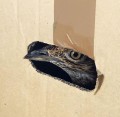 Threats
Threats 
Threats
The actions of the project will try to contrast the species’ decrease in peninsular Italy, reducing the
threats of the area.
Therefore, a viable population of the species will be restored, starting from the conservation of its
habitat in the agro pastoral context, and at the same time the ecological needs of the species in
our land will be studied.
Among the principal threats there are:
1) The drastic reduction of the peninsular Italian population
The population of Tetrax tetrax is the last population in the peninsular Italy and it’s taking a
serious risk of extinction for both external (see 2nd
inbreeding (repeated crossbreeds among consanguineous that causes infertility).
threat) and internal causes, as the risk of
This threat comes from other threats of the past, as poaching and land planting of natural
pastures, which are not actual anymore because of the creation of a status of legal protection for
the interested areas of the project (national parks, SCI, SPA) and also because of the progressive
reduction of hunting activity (both legal and illegal) registered in the last decades in Italy.
At present, the extreme reduction of the population represents a threat because the small
number of specimens does not allow the restoring of the population without an active politic of
conservation of the species (restocking and improvement of the habitat).
2) The impact of anthropic activities
The passage from the traditional agriculture to a highly mechanized one caused on the rural areas
a remarkable increase of the agricultural activity’s negative incidence on Little bustard, due to
the use of machines and to the premature harvest of the agricultural produce (wheat and forage
plants), supported by the use of premature cultivar.
Moreover, mushrooms’ or other produce’s (spontaneous herbs, snails) collectors, naturalist
photographers and birdwatchers frequent the breeding areas: this represents another cause of
disturbance. Even though the Tetrax tetrax male’s lek are only located in pasture areas, females
can also lay eggs in cereal areas by the lek.
The mechanization in agriculture, i.e. the use of tractors, harvester-threshers, etc., and the harvest
during the Little bustard’s breeding season without a suitable harvesting technique (which could
for example include the use of fledging bars and hay mode, that could help the animals in reaching
the shelters), are important factors of mortality for females, eggs and young and involves the
impossibility to conclude the reproductive cycle, due to the premature threshing. In the same way,
the disturbance caused by humans on the area can lead to a further decrease in productivity of
the specimens of Little bustard in Apulia and can also be one of the causes of the local extinction
of the species, being the specimens less than the minimum number for a viable population.
3) The lack of knowledge on the species’ biology at the regional level
Even though it is not a directly limiting factor, the lack of information, along with the absence of
planning tools (national and local action plans), represents a serious limitation in the realization
of efficacious actions of conservation. Indeed, the negative factors are often known better than
their causes (ex.: low productivity). In particular, important lacks concern: productivity; survival;
ecologic features that establish the stopover, hibernating and breeding sites of the species.
The poor knowledge about the vital needs of the species at national and local level, weigh upon
the individuation of further detractors of the mating success of Tetrax tetrax.

















.jpg)
.jpg)
.jpg)
.jpg)
.jpg)










































.jpg)
























